There are two monuments in front of the main entrance (from ul. Marszałkowska). One is a granite sculpture of Adam Mickiewicz carved by Stanisław Horno-Popławski and the other is Nicolaus Copernicus by Ludwika Nitschowa. Inside the building there are works by, among others, Georgij Iwanowicz Motowiłow. One of his ceramic reliefs Peace Giving Life to the People (c. 1955), made in the Bulganin Factory in Moscow, adorns the wall of the Palace Hall.
“The glazed and gilded composition of the work gives the impression of coming from a church, especially since the author has placed a woman with a baby in the central part, which some tourists see as the Madonna with Child” – writes Tomasz Urzykowski in Gazeta Wyborcza
MDM: Karol Tchorek, Mother with Child
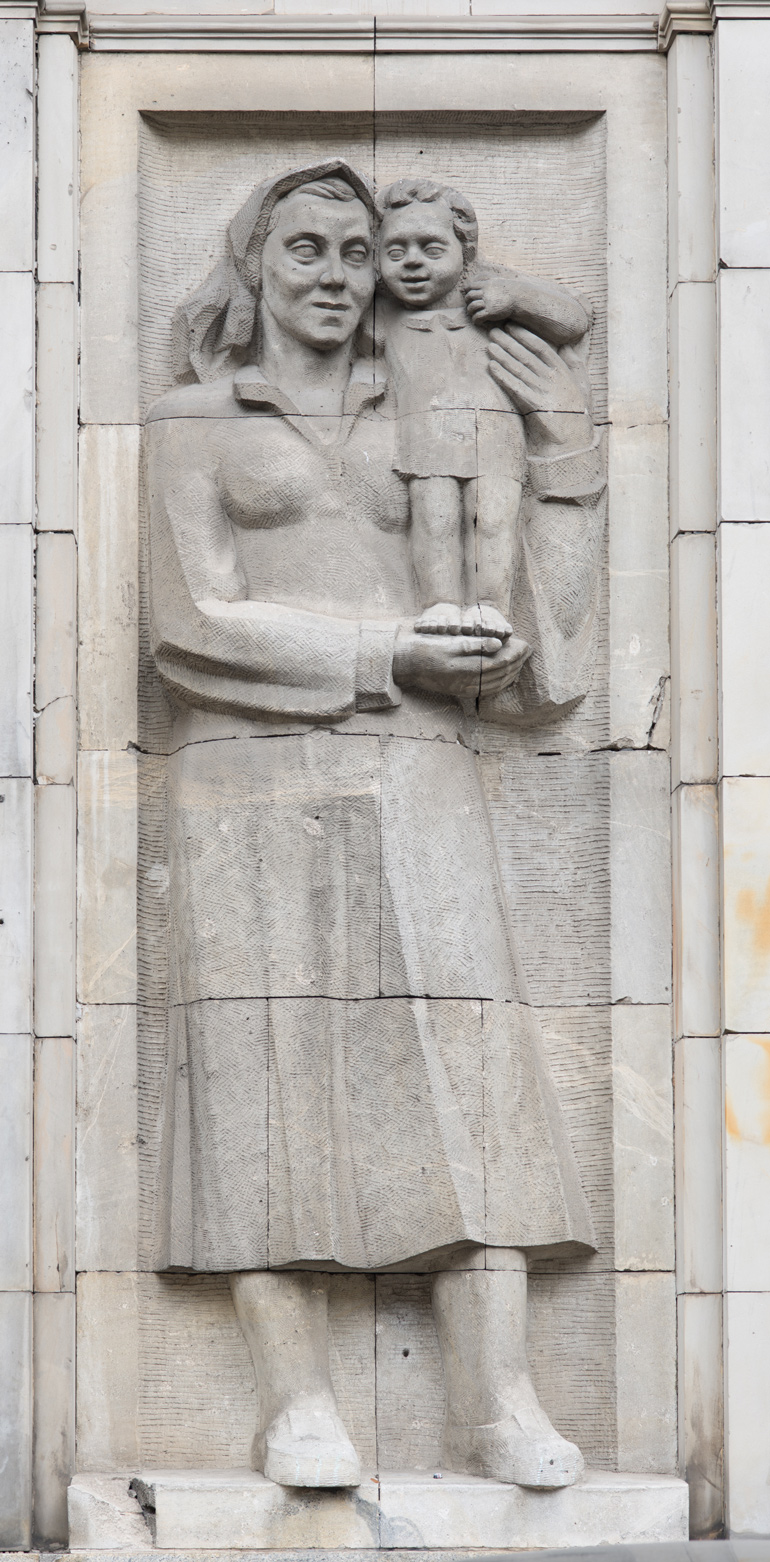 Karol Tchorek, Mother with Child, 1952, Plac Konstytucji (MDM), Warsaw, photo. Szymon Rogiński / courtesy of the artist
Karol Tchorek, Mother with Child, 1952, Plac Konstytucji (MDM), Warsaw, photo. Szymon Rogiński / courtesy of the artistSecond to the Palace of Culture and Science, the biggest gallery of socialist realist sculpture can be found adorning the Marszałkowska Residential District (MDM), today on pl. Konstytucji and ul. Marszałkowska. Here, the facades of the apartment blocks on both sides of the street between pl. Konstytucji and pl. Zbawiciela display eight monumental reliefs. They depict women, men, children, peasants, laborers, and other progressive figures.
From the beginning, the muscular silhouettes and exaggerated proportions aroused controversy – despite the fact that the best sculptors were commissioned for their design (including Jerzy Jarnuszkiewicz and Karol Tchorek). Soviet authorities roared: “the idea of a worker being similar to an animal, with powerful paws and an empty ugly face, is a slander against the Polish workmen building a new Poland. This representation of the worker brings shame to the artist.”
Karol Tchorek (1904-1985) created the work depicting motherhood (1952, ul. Marszałkowska 34/50). This artist, art dealer, and collector is the creator of a well-known Warsaw tableau Sites of Struggle and Martyrdom (1949). About 200 plaques commemorate public executions during World War II. Some of them contain incorrect information (in relation to the number of victims, for example) and despite many interventions, the erroneous subtitles have not been corrected. Tchorek was also the designer of monuments, including those to soldiers and partisans in Ostrow Mazowiecka (1959) and Polish soldiers in Perth (1970). He designed the tombstones of prominent artists Władysław Strzemiński (1962) and Jan Szczepkowski (1965). In 1975, he made the sculpture Warsaw Autumn, which is located on Bohdan Wodiczko Square behind the University of Music in Warsaw.
Franciszek Habdas, Opening of MDM
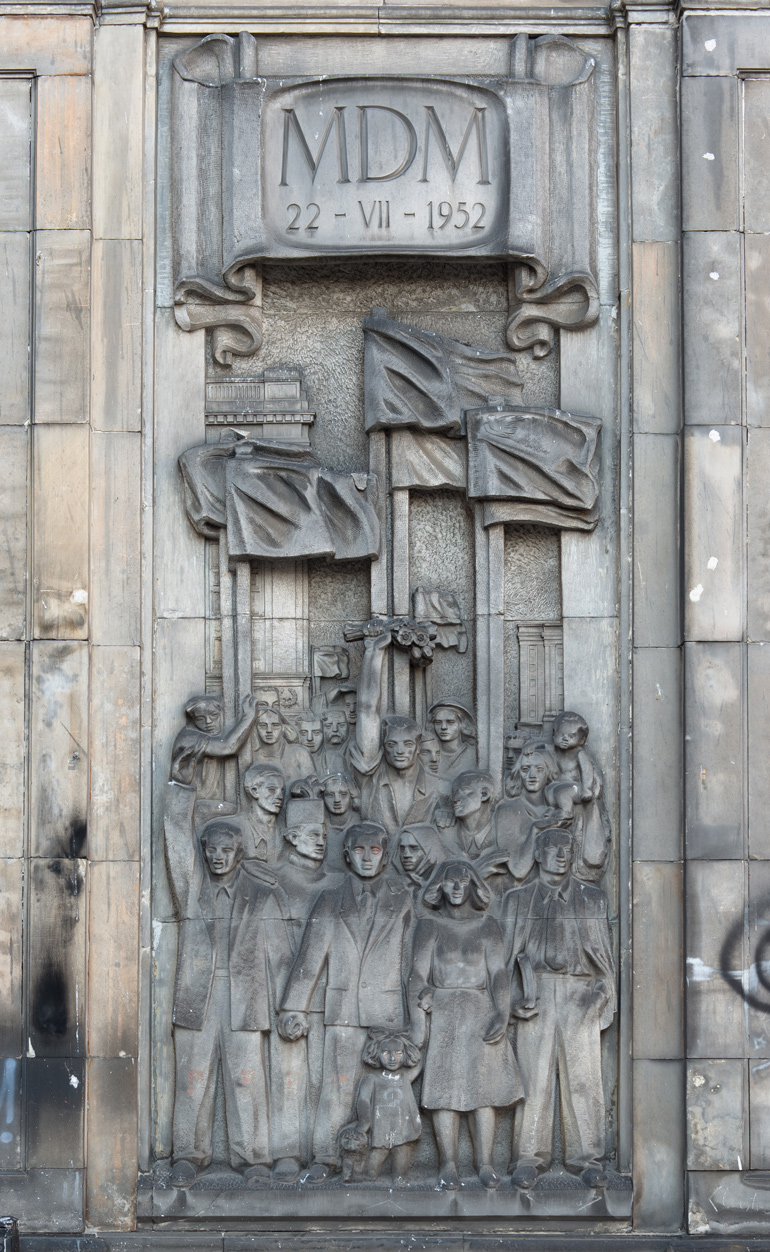 Franciszek Habdas, Opening of MDM, 1952, pl. Konstytucji 3 (from ul. Waryńskiego), Warsaw, photo. Szymon Rogiński / courtest of the artist
Franciszek Habdas, Opening of MDM, 1952, pl. Konstytucji 3 (from ul. Waryńskiego), Warsaw, photo. Szymon Rogiński / courtest of the artistIn the 1950s, Franciszek Habdas (1906-1977) was one of the leading sculptors working with architect Zygmunt Stępiński, the designer or co-designer of many important post-war buildings, including the Palace of Culture and Science, Mariensztat, the Marszałkowska Residential District, and Osiedle Nowy Świat.
Habdas’ most famous bas-relief commemorates the opening of the important downtown residential project, MDM, and is located on the bottom wall of the building on pl. Konstytucji 3 (from ul. Waryńskiego). The work shows a group of adults and children, as if posed for a photo. Above them is a cartouche with the date – July 22, 1952.
Another sculpture by Habdas, The Girl with a Dove (1957), similarly represents the spirit of socialist realism and can be seen in the Rydz-Śmigły Park (near PKP Powiśle). “The girl in the statue is represented in the quintessential style, though she was designed at a time when the doctrine of socialist realism was already fading and strongly criticized” – writes Paweł Giergoń.
Józef Gosławski, Music
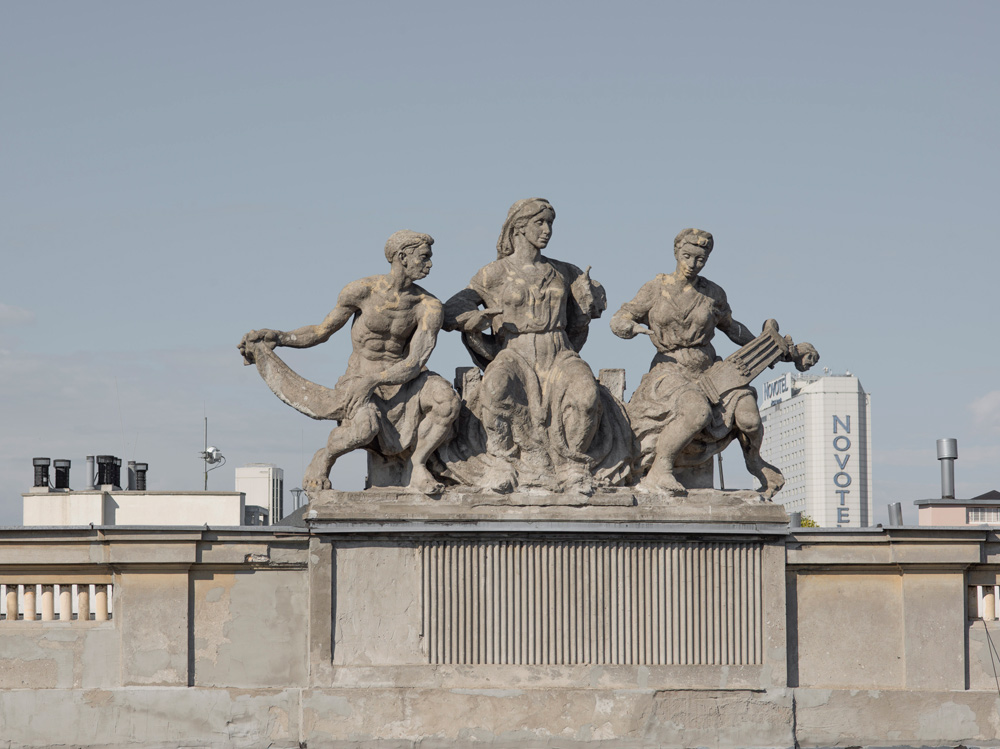 Józef Gosławski, Music, 1952, photo courtest of Królikarnia
Józef Gosławski, Music, 1952, photo courtest of KrólikarniaIn the prewar period, Józef Jan Gosławski (1908-1963) was highly valued for his sculptural caricatures and portraits (his few surviving works include Portrait of Maria Maro from 1937, which is owned by the Polish Embassy in Rome). After World War II, his work was dominated by monumental sculpture and medals. Among his best known designs are the Statue of Frederic Chopin in Żelazowa Wola (unveiled in 1969) and coins (including the 5 złoty with the image of a fisherman and the 10 złoty with Copernicus).
In Warsaw, you can admire his allegorical sculpture Music (1952), which is located on the cornice of a residential building at Koszykowa 34/50 (opposite the Faculty of Architecture at Warsaw University of Technology). This work is one of three placed side by side – the others are Kazimierz Bieńkowski’s Fine Art and Leon Machowski’s Literature.
“…the group of sculptures was barely finished for the sumptuous opening of the building. After the event, the expressive, talkative, gesticulating group suggesting the successful development of high culture in the socialist state was to be forged in a more permanent, nobler material” – explains the website of the exhibition.
Jerzy Jarnuszkiewicz, Preschoolers
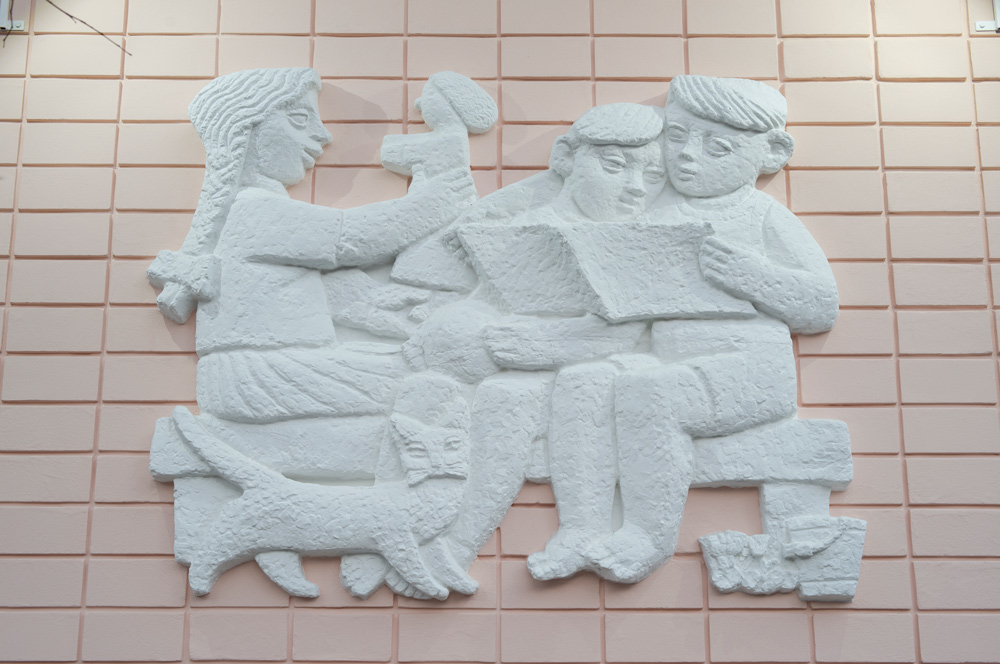 Jerzy Jarnuszkiewicz, Preschoolers, 1947, photo courtesty of Królikarnia
Jerzy Jarnuszkiewicz, Preschoolers, 1947, photo courtesty of KrólikarniaJerzy Jarnuszkiewicz (1919-2005) is one of the most outstanding Polish artists of the second half of the twentieth century and was a teacher of several generations of artists. In addition to monumental sculptures – his most famous work is the statue Little Insurgent (1946) in Warsaw’s Old Town – he completed a number of commissions for architectural sculptures in the second half of the forties. His work adorns, among others, the kindergarten at Mariensztat (1947, ul. Sowia 4) and a home on ul. Katowicka (1947). His reliefs maintained the style of the interwar period, defined as “graphic” (with gouging and drawing with the stylus) and combined with his later metal works.
Jarnuszkiewicz’s Metallurgist and Teachers (1952) also decorate the MDM (between pl. Konstytucji and pl. Zbawiciela). In the mid-50s, the artist’s work shows a significant reevaluation that parallels the evolution of cultural policy in the PRL (and the end of the monolithic power of socialist realism).
Piotr Kann, Putti Rebuilding Warsaw
 Piotr Kann, Putti Rebuilding Warsaw, 1955-58, ul. Świętojańska 11, Warsaw, photo. Szymon Rogiński / courtesy of the artist
Piotr Kann, Putti Rebuilding Warsaw, 1955-58, ul. Świętojańska 11, Warsaw, photo. Szymon Rogiński / courtesy of the artistAfter World War II almost completely destroyed Warsaw, everyone worked to rebuild, even naked angles. The work was immortalized by Piotr Kann in a classicist stucco frieze on an Old Town building located at ul. Świętojańskiej 11. The frieze depicts heads, putti, and coat of arms of Warsaw and was created during the reconstruction of the building in 1955-58, based on Halina Kosmólska’s design.
Maksymilian Potrawiak, The Grape Harvest
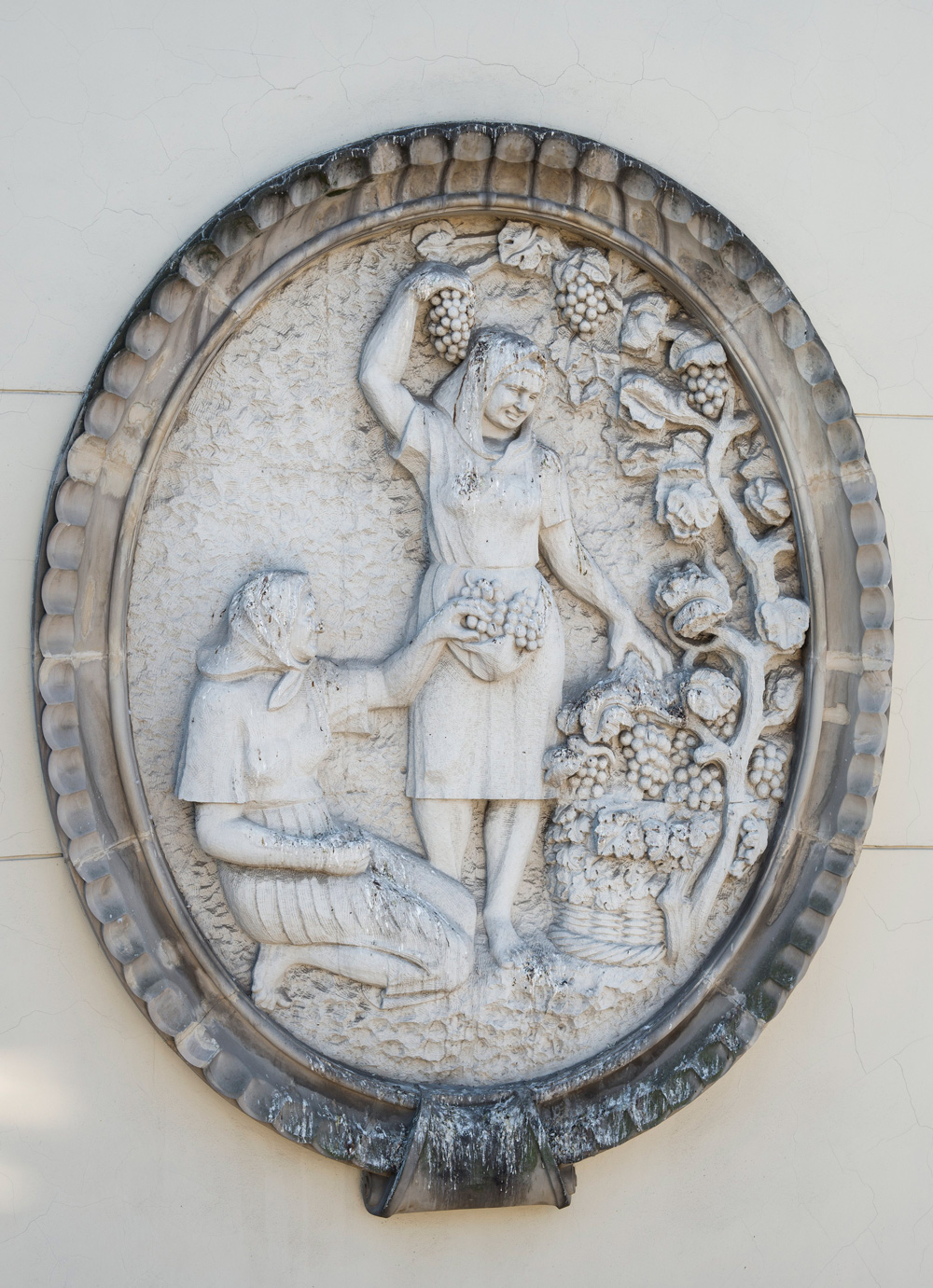 Maksymilian Potrawiak, The Grape Harvest, 1952, photo. courtesty of Królikarnia
Maksymilian Potrawiak, The Grape Harvest, 1952, photo. courtesty of Królikarnia Trained as a sculptor, Maksymilian Potrawiak (1910-1986) worked even while in German captivity after the fall of the Warsaw Uprising, creating ornaments and decorations in the three POW camps where he was held. At that time, he was already the creator (along with sculptor Stanisław Sikora and architect Jan Bogusławski) of a mausoleum for General Gustaw Orlicz-Dreszer in Gdynia in 1939. The mausoleum was blow up by Germans two months after its completion.
He is also the creator of an idyllic scene of grape harvest enclosed in an oval medallion (1952) and located on a downtown apartment building (ul. Wilcza 33/ul. Marszałkowska 64). The bas-relief is one of the enigmatic elements that decorate the area. Its subject matter is sometimes linked with a deli named Bachus that was open at the address.
Adam Smolana and the Stonemasonry Workshop
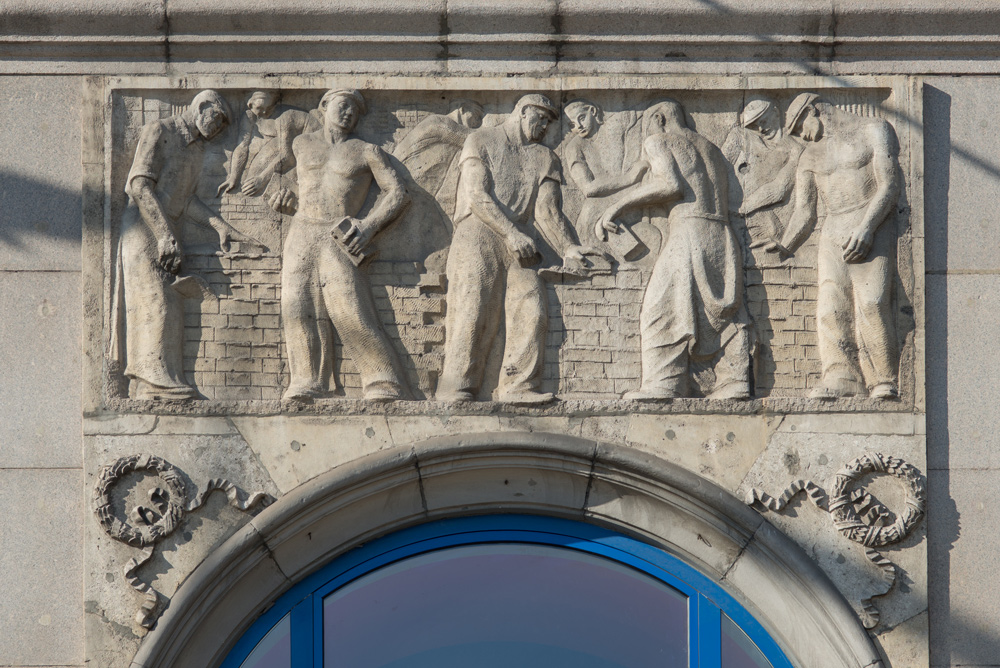 Ludwika Nitschowa, Masonry, 1952, ul. Piękna 28/34, Warsaw, photo. Szymon Rogiński / courtesy of the artist
Ludwika Nitschowa, Masonry, 1952, ul. Piękna 28/34, Warsaw, photo. Szymon Rogiński / courtesy of the artistThe biggest series of Adam Smolana’s (1921-1987) architectural sculptures was created for the rebuilding of Gdańsk in the first half of the 1950s. In Warsaw, the designer and his team of architects created a series devoted to the history of the Marszałkowska Residential District (1952). Six reliefs were placed on the building at ul. Marszałkowska 53 (including Stonemasonry Workshop and On the advice of architects). They represent the mental work of a team of architects and planners, as well as the physical work of sculptors, stonemasons, bricklayers, and other construction professionals.
“Thanks to their joint efforts, a revolutionary change was made – as envisioned in Adam Ważyk’s verse, people have come to the city center” – the organizers wrote of their “rhetorical figures.”
Workers Attributed to Alina Szapocznikow
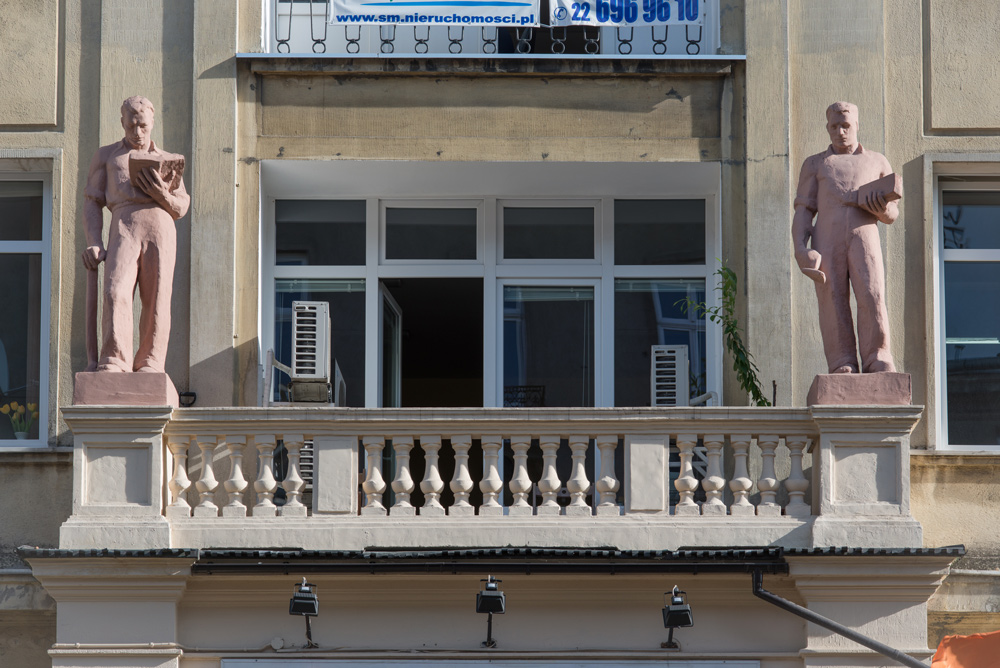 Attributed to Alina Szapocznikow, Workers, approx. 1952, ul. Mokotowska 4/6, Warsaw, photo. Szymon Rogiński / courtesy of the artist
Attributed to Alina Szapocznikow, Workers, approx. 1952, ul. Mokotowska 4/6, Warsaw, photo. Szymon Rogiński / courtesy of the artistOne of the most outstanding Polish sculptors of the second half of the twentieth century, Szapocznikow (1926-1973) used her personal experience of the war and her fight with terminal illness to create a personal language that reflected the changes that occur in the human body. For this purpose, she introduced new materials to the sculptor’s workshop and boldly created moving works with exceptional power of expression.
Szapocznikow was also responsible for a number of socialist realist sculptures. She participated in competitions, including the Polish-Soviet Friendship, Heroes of Warsaw, and Victims of Auschwitz. In the mid-50s, her works were included with those on the Palace of Culture. An earlier work, Workers (approx. 1952, ul. Mokotowska 4/6) decorated the post-war headquarters of the Trade Union of Construction Workers and Ceramics Related Occupations (now the home of the European Academy of Photography).
Jan Ślusarczyk, Dance, Work, Cultivation
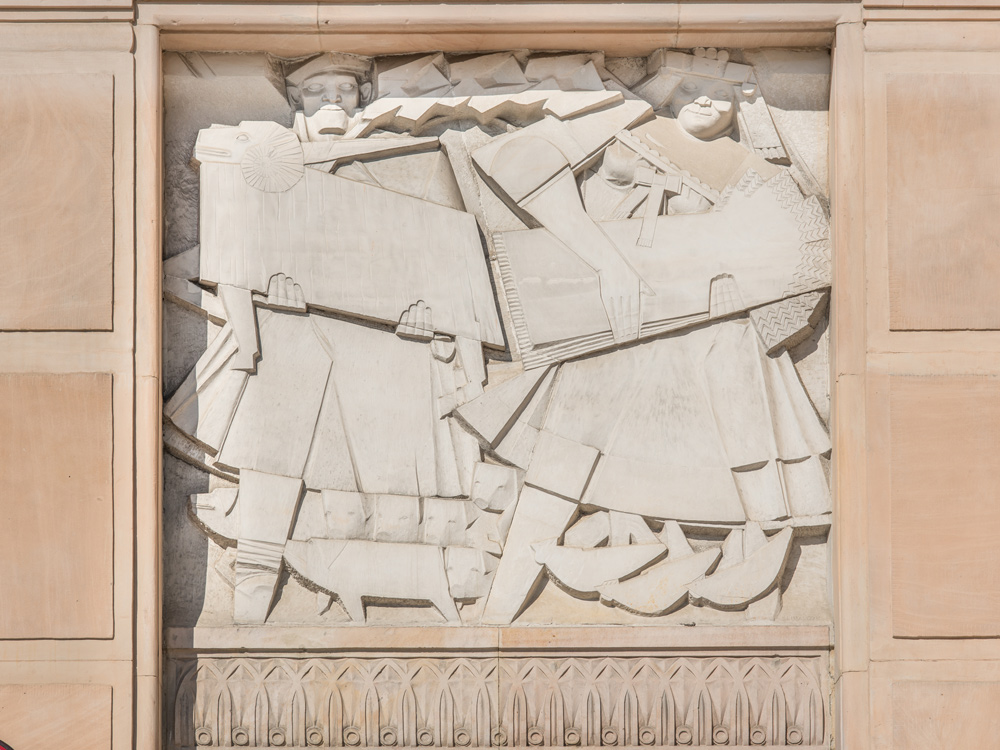 Jan Ślusarczyk, Cultivation, 1953-56, Ministry of Finance, ul. Świętokrzyska 12, Warsaw, photo. Szymon Rogiński / courtest of the artist
Jan Ślusarczyk, Cultivation, 1953-56, Ministry of Finance, ul. Świętokrzyska 12, Warsaw, photo. Szymon Rogiński / courtest of the artistIn the first years after World War II, Jan Ślusarczyk (1903-1980) created many works in the spirit of socialist realism. These include the sarcophagus for General Świerczewski in Warsaw’s Powązki Cemetery (1948-1949), the Monument of Thanks to the Soviet Army in Bialystok (1951), and sculptures in the Park of Culture in Chorzów (i.e. Monument to Metallurgists, 1953-1955).
Of his bas-reliefs on the building of the Ministry of Finance in Warsaw (ul. Świętokrzyska 12) – Dance, Work, and Cultivation (1953-1956) – the organizers of the exhibition in Królikarnia wrote,
“The exceptionally light and clear presentation is not quite at odds with the seriousness of the ministerial building. The ingenuity and skill of sculptor can especially be seen in the stylized animals and elements of Cultivation."
Sources: figuryretoryczne.pl, culture.pl, ekultura.asp.gda.pl, wyborcza.pl, www.sztuka.net, own materials
Author: Agnieszka Sural, 24.07.2015
Translation: A. Aniskiewicz 29.07.2015